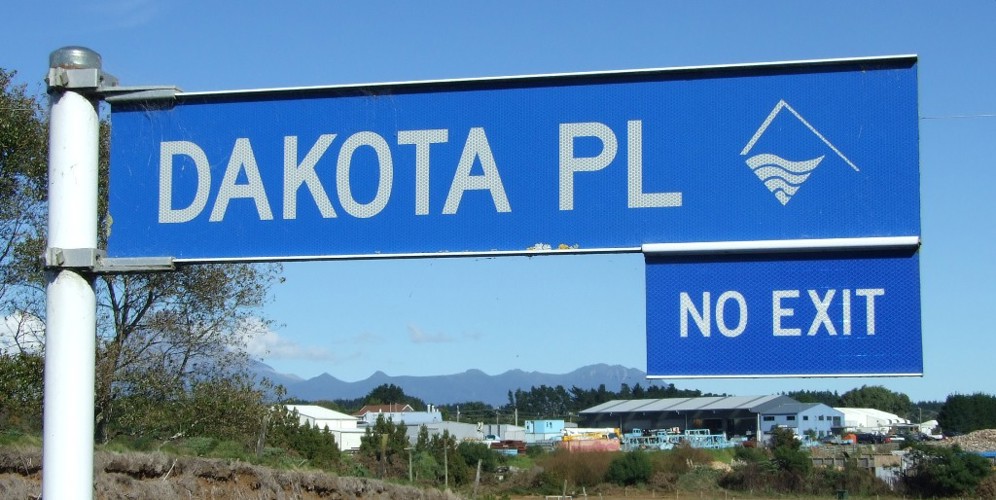 Dakota Place sign (2013). Mike Gooch. Word on the Street image collection.
Dakota Place sign (2013). Mike Gooch. Word on the Street image collection.
 Dakota Place sign (2013). Mike Gooch. Word on the Street image collection.
Dakota Place sign (2013). Mike Gooch. Word on the Street image collection.
Dakota Place celebrates an aircraft that revolutionised air transport in the 1930s and 1940s. Dakota is the name given to the military version of the Douglas DC3 aircraft. Both versions have been seen in the skies around Bell Block during and after the Second World War.
New Plymouth Airport opened in 1933 on land adjacent to Dakota Place, but became the RNZAF Bell Block Base during the Second World War, only to revert to a domestic role after 1945. The necessity to move the airport in the 1960s came when the then national carrier NAC (National Airways Corporation) changed its fleet from DC3s to Fokker Friendship F27 aircraft that needed better approaches and a sealed runway.
Up until then the DC3 had been the workhorse as it had in a large part of the rest of the world. This was the aircraft that brought comfortable, fast and long range air travel to the world.
Its genesis was in the heavy competition between two American airlines competing for the transcontinental trade. United had a deal with Boeing for their 247 aircraft and TWA couldn't get any 247s, as Boeing had agreed to finish a sixty plane order with United ahead of anything else. So TWA approached Douglas for a design which saw the production of the DC1 in 1933 and a year later the DC2.
At this point American Airlines entered the discussion convincing a reluctant Donald Douglas to produce a sleeper aircraft based on the DC2 to replace its Curtiss Condor biplane. In 1935 the DST (Douglas Sleeper Transport) first flew on the 32nd anniversary of the Wright Brothers efforts at Kitty Hawk. Only seven were built, then the sleeping berths were replaced with 21 passenger seats and designated the DC3. Domestic and international air travel had become a reality.
At the outbreak of the Second World War, Douglas produced the military version the C47 Dakota which gives its name to the street.
Over 16,000 DC3s were built and many remained in service until the 1970s. Even in 2010 some small companies still operated DC3s as commercial passenger and freight services. Certainly their ability to take off and land on grass and dirt strips makes them useful in developing countries. It also testifies to their rugged reliability which had them referred to as "a collection of parts flying in close formation".
This story was originally published in the Taranaki Daily News.
Please do not reproduce these images without permission from Puke Ariki.
Contact us for more information or you can order images online here.